In today’s digital world, accessibility is more important than ever. Screen readers play a crucial role in ensuring that individuals with visual impairments or other disabilities can access and interact with digital content. Whether you’re using a computer, smartphone, or tablet, screen readers provide a way to navigate interfaces, read text aloud, and enable an inclusive digital experience. In this comprehensive guide, we will explore how to turn on screen reader support across different devices, discuss key features, and provide a detailed comparison table.
Enhancing Accessibility in Online Learning
What is a Screen Reader?
A screen reader is an assistive technology that reads text on a screen aloud, allowing visually impaired users to interact with content. These tools convert text, icons, and other graphical elements into speech or braille output. Screen readers are commonly used in operating systems, applications, and web browsers to enhance accessibility.

Why Use Screen Reader Support?
Enabling screen reader support provides numerous benefits, including:
- Accessibility: Empowers individuals with visual impairments to independently navigate digital interfaces.
- Improved Productivity: Allows users to efficiently interact with digital content without visual assistance.
- Compliance: Ensures adherence to web accessibility standards such as WCAG (Web Content Accessibility Guidelines).
- Enhanced User Experience: Provides an alternative mode of interaction that benefits elderly users or those with temporary disabilities.
How to Turn On Screen Reader Support
Windows
Windows includes a built-in screen reader called Narrator, which can be activated as follows:
- Press Windows + Ctrl + Enter to toggle Narrator on or off.
- Alternatively, go to Settings > Ease of Access > Narrator and toggle the feature on.
- Customize settings such as voice speed, pitch, and verbosity in the Narrator settings.
macOS
Apple devices come with the VoiceOver screen reader, which can be enabled by:
- Press Command + F5 to turn VoiceOver on or off.
- Navigate to System Preferences > Accessibility > VoiceOver to enable and configure it.
- Use the VoiceOver utility for advanced customization.

Android
Android devices feature the TalkBack screen reader, which can be activated by:
- Go to Settings > Accessibility > TalkBack and toggle it on.
- Follow the tutorial to learn gestures and shortcuts.
- Use two-finger swipes and taps to navigate.
iOS
For iPhone and iPad users, VoiceOver can be enabled with:
- Navigate to Settings > Accessibility > VoiceOver and toggle it on.
- Use triple-click on the home button (or side button for newer models) to activate.
- Customize gestures, speech rate, and verbosity levels.
Web Browsers
Most modern web browsers support screen readers, such as:
- Chrome: Works well with ChromeVox extension.
- Firefox: Optimized for NVDA and JAWS screen readers.
- Edge: Fully compatible with Narrator and JAWS.
Key Features of Popular Screen Readers
| Feature | Windows (Narrator) | macOS (VoiceOver) | Android (TalkBack) | iOS (VoiceOver) |
|---|---|---|---|---|
| Text-to-Speech | Yes | Yes | Yes | Yes |
| Braille Display Support | Yes | Yes | Limited | Yes |
| Gesture Navigation | Limited | Extensive | Extensive | Extensive |
| Customizable Voice | Yes | Yes | Yes | Yes |
| Web Browser Support | Yes | Yes | Yes | Yes |
| Shortcut Commands | Yes | Yes | Yes | Yes |
Tips for Using Screen Readers Effectively
- Learn Keyboard Shortcuts: Familiarize yourself with shortcut keys to enhance navigation speed.
- Customize Settings: Adjust voice speed, pitch, and verbosity to match your preference.
- Practice Gestures: For mobile users, mastering screen reader gestures improves usability.
- Use Headphones: Ensures privacy and clearer audio when navigating content in public.
- Stay Updated: Regular updates bring improvements and new features to screen readers.
Common Challenges and Solutions
Despite their benefits, screen readers can present some challenges:

- Complex Websites: Some sites are not optimized for screen readers, leading to navigation difficulties. Solution: Use screen-reader-friendly websites or enable Reader Mode in browsers.
- Performance Issues: Older devices may experience lag. Solution: Keep software updated and limit background applications.
- Steep Learning Curve: It takes time to master. Solution: Follow tutorials and practice frequently.
FAQs
1. Can I use screen readers with third-party apps?
Yes, most popular apps like WhatsApp, Facebook, and Gmail have built-in support for screen readers.
2. Do screen readers work offline?
Yes, once enabled, screen readers can function offline for reading local files and content.
3. Are screen readers free?
Many built-in screen readers are free, but third-party options like JAWS may require a purchase.
4. Can I adjust the screen reader’s voice?
Yes, you can customize the voice type, pitch, and speed through settings.
5. Are screen readers compatible with braille displays?
Yes, most modern screen readers support braille displays for tactile reading.

Conclusion
Screen readers are invaluable tools for accessibility, providing individuals with visual impairments the ability to engage with digital content effectively. Whether you’re using Windows, macOS, Android, or iOS, enabling screen reader support is straightforward and can greatly enhance productivity and independence. By following the steps outlined in this guide and utilizing the provided tips, users can maximize the benefits of screen reader technology.
Make sure to explore different settings and find what works best for your needs to enjoy an inclusive digital experience.



